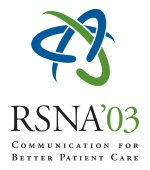
Abstract Archives of the RSNA, 2003
Steven Hetts MD, PRESENTER: Nothing to Disclose
Abstract:
HTML
Purpose: Agenesis of the corpus callosum (ACC) is a cerebral malformation associated with seizures and profound cognitive and motor impairment. Incidence is 1:4000 live births. Little is known about the natural history and etiology of ACC. The goal of the current study is to recognize phenotypic groupings that will facilitate identification of genes mutated in this spectrum of disorders and lead to a better understanding of callosal formation.
Methods and Materials: Medical records of individuals with callosal agenesis or dysgenesis seen at a large teaching hospital over the last 18 years were retrospectively reviewed. MRIs and reports were assessed for presence or absence of: interhemispheric cyst, cerebral dysgenesis, heterotopia, mid/hindbrain abnormalities, and hydrocephalus.
Results: Of 167 patients identified, complete ACC was reported in 40 (24%) and partial ACC in 127. 44 patients (26%) had mid/hindbrain anomalies (40 Chiari II and 8 Dandy-Walker) and 60 patients (36%) had hydrocephalus requiring shunting. Of the 49 patients with interhemispheric cysts, 29 were male and 19 were female (p=0.15, chi-squared=1.04). In contrast, patients with complete ACC and no midline cyst, 16 were male and 4 female (p<0.015, chi-squared=6.06). This skewed ratio suggests X-linked inheritance. Of the 40 patients with reported complete ACC, 20 MR studies were retrievable and these were reviewed. Of this subset, 17 patients were confirmed to have complete ACC, 1 had partial ACC, and 2 were excluded from further study because the corpus callosum appeared intact. Of the 18 patients with partial or complete ACC, all had at least one other brain anomaly. 13 had no interhemispheric cyst, 1 had a type I cyst (communicating with ventricular system), and 4 had type II (noncommunicating) cysts. 8 of 15 patients lacked an anterior commissure; 12 of 14 lacked a hippocampal commissure. Cortical malformations were present in 13 of 15 patients (6 heterotopia, 6 abnormal sulcation, and 1 with both). 15 of 18 patients had enlarged cerebral ventricles, ranging from mild colopocephaly to severe hydrocephalus. White matter volume was decreased in 17 of 18 patients; 5 of 16 patients also demonstrated abnormal or delayed myelination. Cerebellar hemispheric hypoplasia was present in 3 of 15 cases and vermian hypogenesis in 5 of 16.
Conclusion: Isolated ACC seems to be quite rare. Most cases are associated with a complex variety of telencephalic, diencephalic, and rhombencephalic anomalies. Not surprisingly, white matter abnormalities are most frequent among the MR findings assessed.
Questions about this event email: steven.hetts@radiology.ucsf.edu
Hetts MD, S,
Agenesis of the Corpus Callosum: MR Analysis of the Phenotypic Spectrum. Radiological Society of North America 2003 Scientific Assembly and Annual Meeting, November 30 - December 5, 2003 ,Chicago IL.
http://archive.rsna.org/2003/3103074.html

